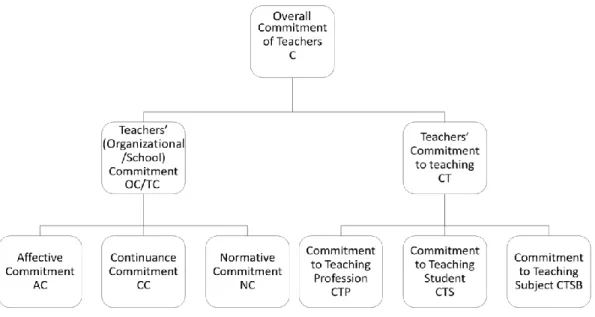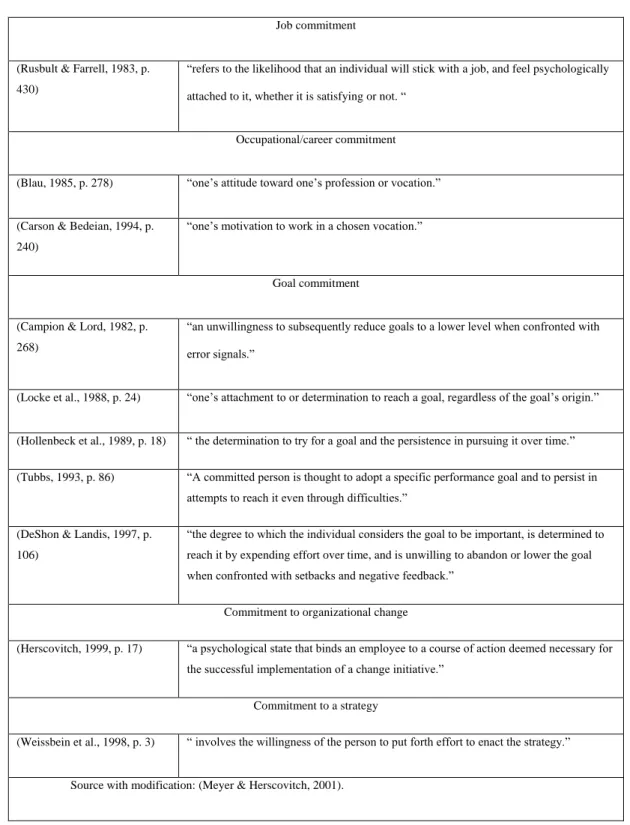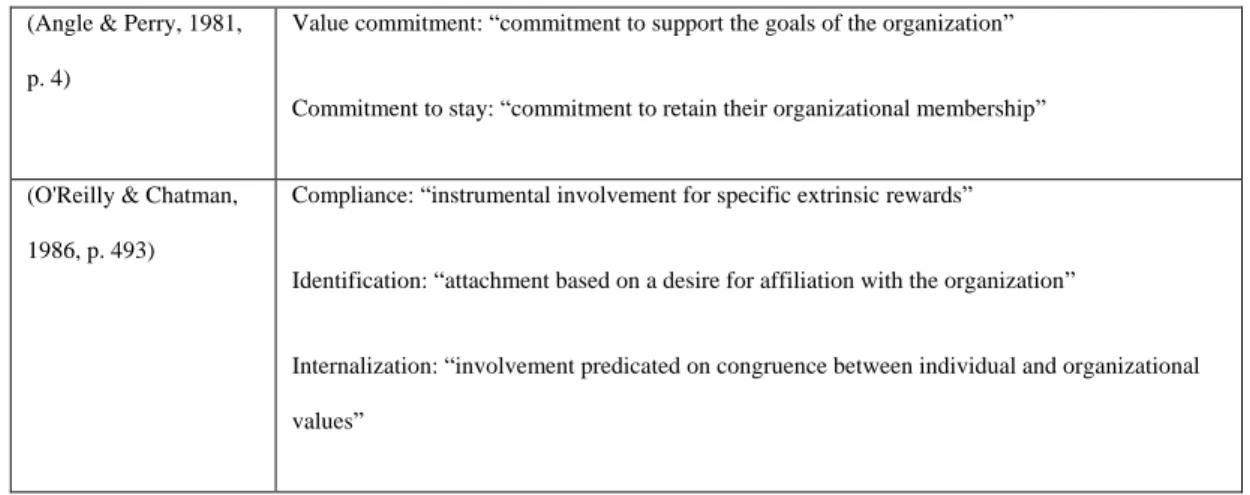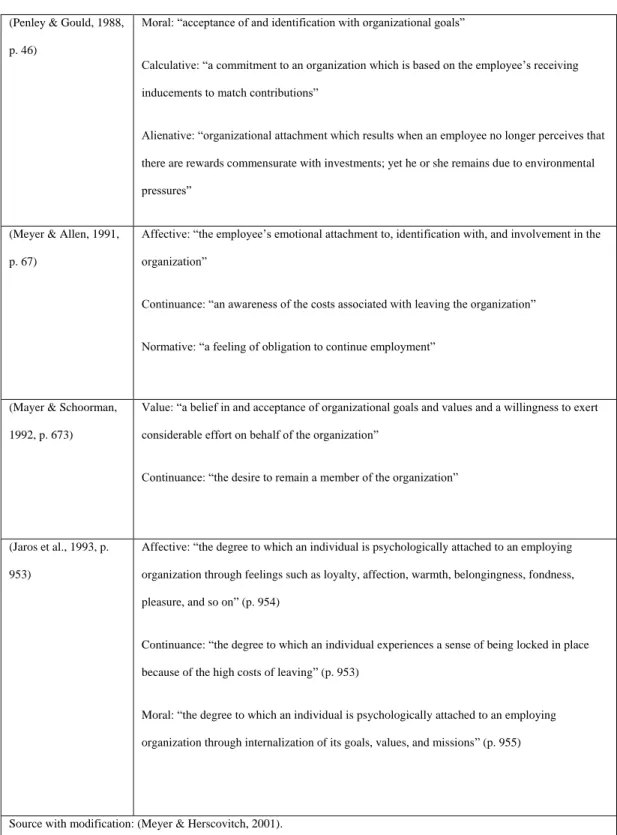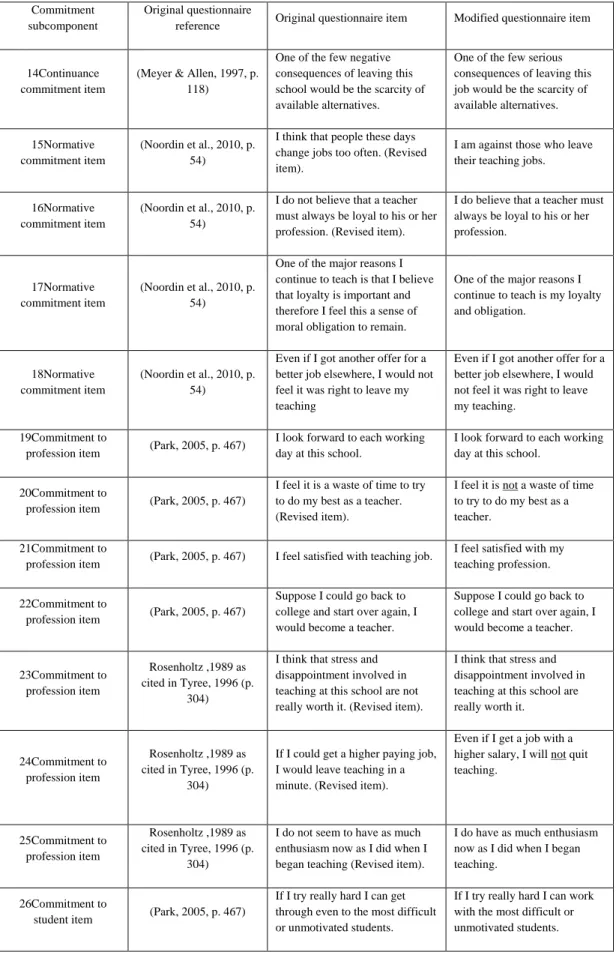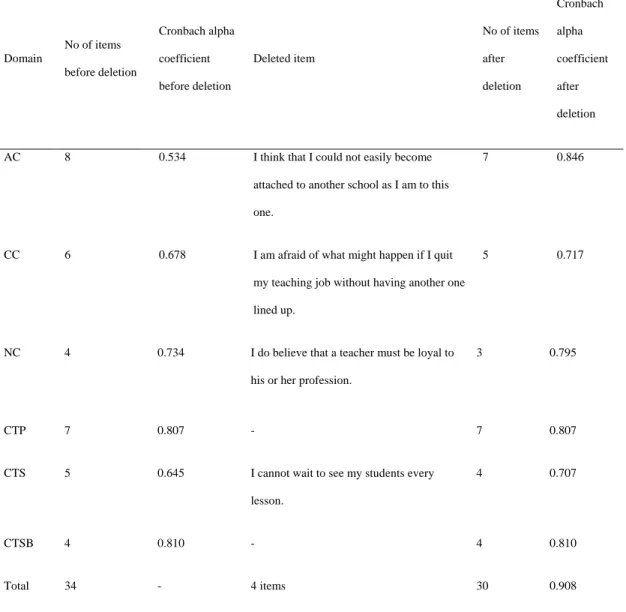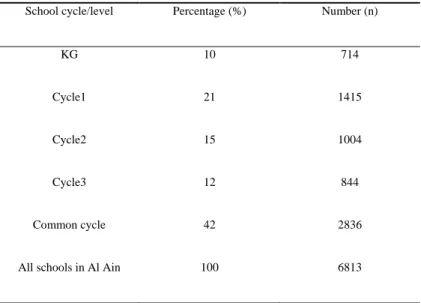The objectives of this dissertation investigated teachers' levels of commitment during times of change in the Abu Dhabi Department of Education and Knowledge (ADEK) and related variables that may increase or decrease their commitment. Results revealed several statistical relationships between teachers' commitment in ADEK schools and teachers' demographic variables.
Introduction
- Overview
- Statement of the Problem
- Purpose of the Study
- Research Questions
- Significance of the Study
- Definitions of Terms
- Delimitation/Limitation
- Study Outline
Therefore, the purpose of this study is to investigate the topic of teachers' engagement and its nuances in. In particular, there have been no studies on teacher engagement in ADEK schools, to the best of the researcher's knowledge.
Relevant Literature
Commitment of Teachers
- Commitment as Side-Bets
- The Psychological Attachment Approach
- The Multidimensional Approaches
Therefore, its items reflect more the attitudinal approach of the OCQ rather than behavioral intentions (Mowday et al., 1982). A later stronger criticism raised by Ko et al. 1997) when they considered the discriminant and content validity of the Meyer and Allen scales.
Framework of the Study
Second, these different forms of engagement in teaching can affect teaching outcomes differently. The second type of commitment is CT and it was assessed through their commitment to the teaching profession itself (CTP), commitment to teaching students (CTS) and commitment to teaching subject (CTSB) (Tyree, 1996).
What is Commitment?
- Is Commitment A Unidimensional or Multidimensional
- Meyer and Allen’s Three-Component Model
- O’Reilly and Chatman’s Model
- Other Multidimensional Conceptualizations
Mowday et al., 1979, p. 226) “the relative strength of an individual's identification with and commitment to a particular organization.”. Continuity: “the extent to which an individual experiences the feeling of being trapped because of the high cost of leaving” (p. 953).
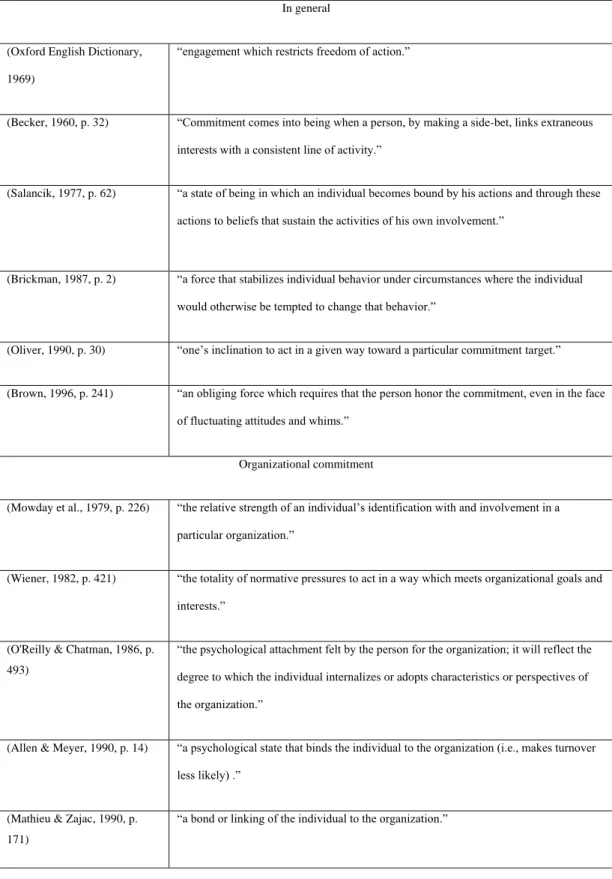
Implications: Commitment as a Multiple Mind-Set
Furthermore, the authors of many models have explained that individuals can become committed to a specific action, which is the result of a cost-avoidance mindset known as CC (Meyer & Allen, 1984; Meyer & Allen, 1991). Mayer & Schoorman, 1992; Jaros et al., 1993), or known as alienating commitment as in Penley and Gould's (1988) model (Penley & Gould, 1988) (Table 3). Finally, Meyer and Allen (1991) identified NC as a perceived obligation to follow an action plan and to be a separate dimension of commitment from the affective and cost-based forms of commitment dimensions (Meyer & Allen, 1991; Meyer et al., 1993).
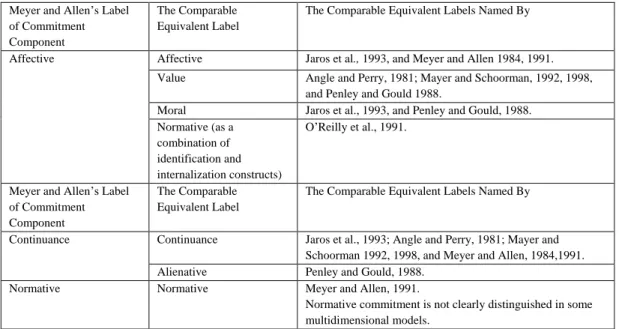
Commitment to What? The Entity-Behavior Distinction
In the case of commitment to a company when the behavior of interest is identified (eg, continued employment and achievement of organizational goals), it is preferable to anticipate the results of the commitment to a company, rather than when the behavior of interest is not identified. It is the same condition for committing to a course of action in which individuals exercise their conduct, with considerable discretion, to which they are committed.
Behavioral Consequences of Commitment
Meyer and Herscovitch (2001) added that the committed individual always has some discretion to specify the terms of the commitment, as it is more likely to be interpreted more liberally for AC than for the other forms of commitment. Finally, even in the case of AC, the correlations linking the behavioral consequences of commitment are modest (Meyer & Herscovitch, 2001).
Teacher Organizational Commitment (OC) and Commitment to
- Teacher Organizational Commitment/ Teacher Commitment
- Teachers’ Commitment to Teaching (CT)
Continuance commitment (CC): Becker (1960) developed what is referred to as CC, which is characterized by “the tendency to engage in consistent lines of activity”. p. 33), such as remaining in an organization and focused on the employee's awareness and recognition of the costs associated with leaving the organization. Therefore, what follows is a detailed discussion of the types of engagement in teaching that were previously highlighted in the study framework. For example, school schedules and the structure of the school day may not allow teachers to spend much time with individual students, limiting teachers' understanding of their students' developmental needs.
Antecedents of Teachers’ Commitment
- Personal Characteristics
- Organizational Characteristics
- Task Characteristics
In this study, these two dimensions of teachers' commitment are used as a foundation to develop a multidimensional measure of teachers' commitment scale to measure these two dimensions in a sample of Al Ain government school teachers. Despite these theories, psychological constructs are used to explain these mechanisms through which social organizational factors influence commitment, where the impact of workplace conditions on the teachers' sense of professionalism is investigated. Examples of teaching job characteristics include the range and variety of teaching skills and knowledge required by the education system, the range of teaching tasks and their meaning, teachers' autonomy in carrying out teaching tasks, and whether feedback on their teaching performance is available (Riehl & Sipple have assessed applicability of job design theory to teaching where they found that task boundaries of teaching as work were quite difficult to specify (Charters et al., 1984), and that it was often teachers who were employed.
Consequences of Employee Commitment
- Consequences for Individual Employee
- Consequences for Work-Groups
- Consequences for Organizations
Negative consequences: Mowday et al. 1982) recognized that commitment can have negative consequences and can result in significant opportunity costs for. Thus, such highly committed members may be isolated by others in the group as a way to influence or change their beliefs (Mowday et al., 1982). Organizations composed of highly committed members may be more attractive to people outside the organization.
External Societal Changes and its Impact on Schools
- Socio-Normative Changes
- Demographic Changes
- Economic Changes
- Technological Changes
These socio-normative changes have effects on the nature of the work ethic, aspiration levels, trust and attitudes towards the organization and its work (Mowday et al., 1982). The diverse workforce, according to Mowday et al. 1982), have different aspirations or expectations from their jobs. Moreover, organizations will have more specializations and expertise from other countries and assuming greater input from new employees (Mowday et al., 1982).
Impact of Work Environment Changes on Employees’
These changes are likely to reduce the quality of employee loyalty and commitment to the organization (Mowday et al., 1982; Rosenholtz & Simpson, 1990). Therefore, employees whose jobs are improved by this change may develop greater commitment to the organization. However, NC may decrease if the organization's investment in the employee decreases, for example due to a reduction in the training budget (Meyer et al., 1998).
Changes in the Focus of Employees’ Commitment
- Commitment within the Organization
- Commitment beyond the Organization
Other employees may redirect their focus to obligations that fall outside the organization (Meyer et al., 1998). Commitment to the profession is when employees are no longer able to trust the organization; they choose to redirect their emotional energy toward their profession or occupation. Union workers may shift their focus from the organization to the union when organizational changes occur because they believe that the union can facilitate improved working conditions (Meyer et al., 1998).
Diversity of Employee-Organization Relationships
To manage it, organizations can create different relationships with employees or groups of employees, fostering a different kind of relationship between the employee and the organization. These individuals may be employed by outside agencies to whom temporary work is provided, and the individuals may not be employees of the organization. However, there may be a need to shift the focus of the organization to the profession, customer, career, or different focuses within or outside the organization.
Factors Associated with the Different Commitments Components
- Sex
- Age
- Nationality
- Qualification and Education
- Number of Teaching Years
- School Cycle
- Teaching Subject
- Number of Years in Same School
- Number of Students Teachers Teach
- Teaching Load
- Non-Teaching Duties
- Marital Status
- Teachers’ Number of Children
They also found that age effects are not entirely due to the reason that older workers have. Meyer and Allen (1997) found that employee education level did not appear to be related to AC (Meyer and Allen concurred, finding that higher education level was not significantly related to any form of engagement (Irving et al., 1997).Abdulla and Shaw (1999) found that years of experience in the same position was a strong predictor of AC but not CC.
Educational Changes in Abu Dhabi
- School Changes at a Macro Level
- School Changes at a Micro Level
The National Reading Law was enacted as part of the National Reading Policy in the UAE. The education system in the Emirate of Abu Dhabi has been undergoing reform since 2006 (Hourani, 2014). This partnership was designed to benefit from the private sector's experience in improving the quality of educational output in the public education sector in Abu Dhabi (Hourani et al., 2012).
Internal Changes Led by ADEK Education System on
Along with these questions comes this research that will examine what will ultimately happen to the deployment of ADEK teachers in times of reform and change. The current ADEK reforms, referring to the unification with the MoE to form a single education system, are expected to introduce some changes, and these are expected to affect teacher behaviour. For example, ADEK tends to emphasize job uniformity, routine in practice, and monitoring compliance by schools and teachers.
Methods
Research Design
The Research Instrument
- Reliability of the Questionnaire
- Validity of the Research
For example, the item (I feel emotionally attached to this school) is included in the questionnaire instead of the item (I do not feel emotionally attached to the school), as found in the reversed version of the original questionnaire. The correlation coefficient for the split-half test of the 30-item questionnaire in this quantitative study is 0.791. The second pilot study was conducted to further assess the internal consistency of the questionnaire through repeated measures.
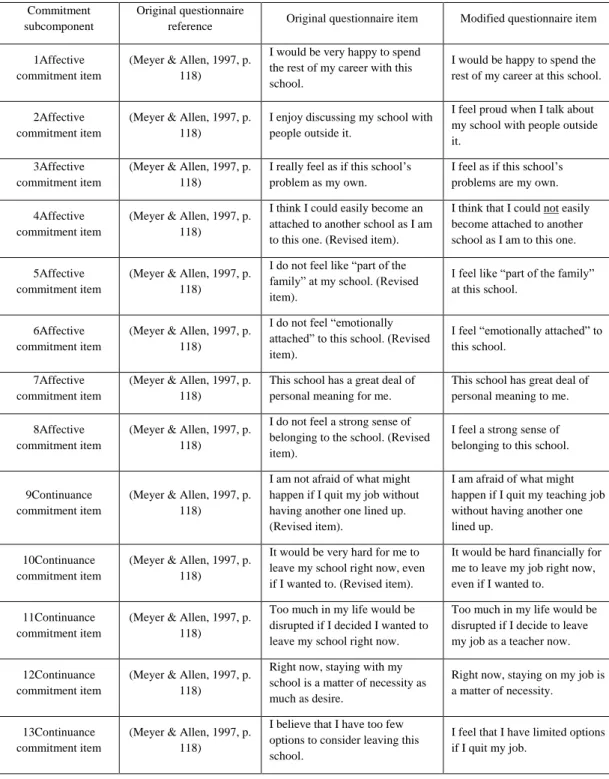
Study Population
Construct validity focuses on a characteristic measured by the instrument and how well the instrument explains differences in individuals' behavior. It involves three steps: a clear definition of the variables to be measured, a hypothesis based on the theory underlying these variables, and empirical and logical testing of the hypotheses (Fraenkel & Wallen, 2009). In this research, the three steps involving the construct-related evidence of validity were covered in the literature review and study framework of this research.
Data Collection
Study Sample
In terms of teaching experience, less than 5% of participants had less than one year of teaching experience. Participants had between one and five years of experience, 16.8% of participants had between six and 10 years of experience, and 20.8% of participants had between 11 and 15 years of experience. The highest teaching experience category consisted of participants who had taught for over 15 years (35.4%). Corresponding percentage of participants without children or two children was presented in the sample with about 16%.
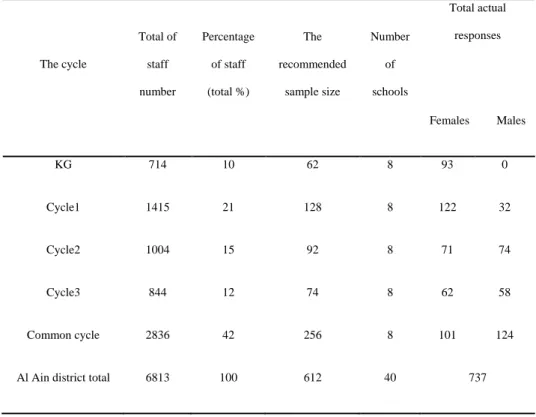
Data Analysis
The second research question will use a bivariate analysis of the variables of general engagement (C) and the OC and TC domains and their six subdomains AC, CC, NC, CTP, CTS and CTSB. The third research question will use a multivariate analysis with a generalized linear model (GLM) analysis between total teacher commitment (C) and thirteen demographic variables (gender, age, nationality, highest degree, teaching experience, school cycle, subject, number of years spent at the same school, number of students taught, teaching load, non-teaching responsibilities, marital status and number of children the teacher has) individually and collectively. Blank cells were filled with correct information if the information was contained in the survey.
Potential Ethical Issues
Two steps were taken to ensure the data was clean and usable before any analysis was performed. As a first step, the data was examined for coding errors, checking all cells with missing data with individual exams to ensure that no data was missing. Implementing these two steps ensured that the results of the statistical procedures were not affected by incorrectly entered data.
Results
The Questionnaire Results
- Univariate Analysis
- Bivariate Analysis
- Multivariate Analysis
The highest mean for AC is for the question where a participant feels like "part of the family" at their school. However, CTS and CTSB show no significant differences based on the teacher's gender. The source of the difference between teachers' educational level and teachers' commitment (C) at the 0.05 level was examined using the Tukey HSD test (Table 27).
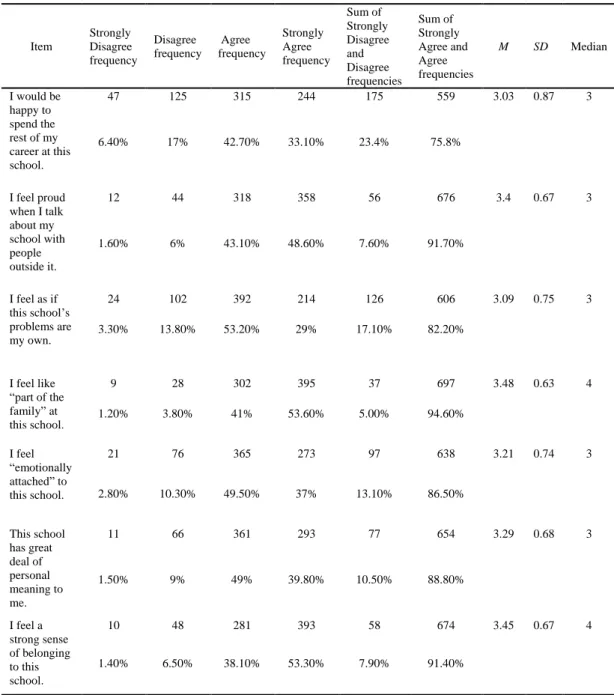
Discussion
Research Question One
- Teachers’ Organizational Commitment (OC)
- Teachers’ Commitment to Teaching (CT)
Research Question Two
- Sex
- Age
- Nationality
- Qualification and Level of Education
- Number of Years as a Teacher in the UAE
- School Cycle
- Subject Taught
- Number of Years in the Same School
- Number of Students a Teacher Teaches
- Teaching Load
- Non-Teaching Duties
- Marital Status
- Teachers’ Number of Children
Research Question Three
Conclusions and Recommendations
Further Research
